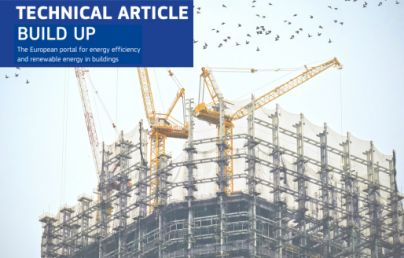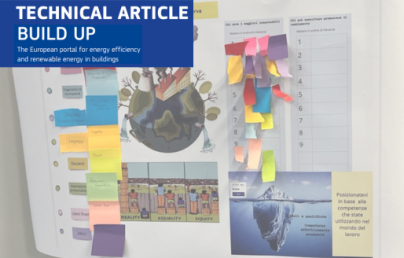Financing schemes: the key for successful energy efficiency projects

Financing schemes: the key for successful energy efficiency projects
In the last years, the improvement of energy efficiency in buildings is one of the main topics pursue at European level able to generate economic, social and environmental benefits.
At EU level several directives as EPDB Energy Performance of Buildings Directive and Energy Efficiency Directive has been published to promote and transport in the EU member states national legislations energy performance requirements of the buildings. Improvement of the energy performance of the housing stock and the energy savings means high investments with long-term payback time, sometimes difficult to support.
To accelerate the energy renovation process at EU level, the cooperation between public and private sectors is increased and innovative financial schemes as Public-Private Partnership (PPP), Energy Performance Contracting (EPC), Crowdfunding (CF) and Green Loans are been developed and used.
Public-Private Partnership (PPP)
EUROSTAT in the European system of accounts, ESA2010 OECD (Organization for Economic Co-Operation and Development) in Recommendation of the Council on Principles for public governance of PPP provide the definition of a Public-Private Partnerships (PPPs) as “long-term agreements between the government and a private partner whereby the private partner delivers and funds public services using a capital asset, sharing the associated risks. In a PPP agreement, the service delivery objectives of the government are intended to be aligned with the profit objectives of the private partner. The effectiveness of the alignment depends on a sufficient and appropriate transfer of risk to the private partners. The private partner may be tasked with the design, construction, financing, operation and management of a capital asset required for service delivery as well as the delivery of a service to the government, or to the public, using that asset. A key element is the bundling of the construction and operation and maintenance of the underlying asset over the life of the contract.”
Currently, the principal forms of PPP contract are management and operating agreements, leases contracts, Build Operate Transfer (BOT) (a type of concession), concessions, contracting models such as Energy Performance Contracting, other variations of concessions.
The European Court of Auditors (ESA) has published an overview of the state of the art and application of PPP in the EU; the main barrier for a successful implementation of the PPP scheme is the lack of well-developed institutional and legal frameworks in all the Member States. Against this, the ESA report reveals that the PPP scheme has been applied successfully in a few Member States that have accumulated sufficient longlasting experience and public sector expertise: 14 of the 18 PPPs approved under the EFSI as of June 2017 were located in France, the United Kingdom, the Netherlands, Italy, Germany, Ireland and Greece. EFSI financing under the Infrastructure and Innovation Window goes to the United Kingdom, Italy and Spain, mainly in the energy (46 %) and in the transport (19 %) sectors.
Energy Performance Contracting (EPC)
Energy performance contracting (EPC) is a mechanism that involves an Energy Service Company (ESCO) which provides various services, such as finances and guaranteed energy savings. The remuneration of the ESCO depends on the achievement of the guaranteed savings. The ESCO stays involved in the measurement and verification process for the energy savings in the repayment period. ESCO and energy performance contracting are mostly found in the public sector and to a lesser extent in the industrial and commercial building sectors.
EU Energy Efficiency Directive also encourages all public bodies including at regional and local level, including social housing bodies, to use Energy Performance Contracting to finance renovations and undertake energy efficiency investments.
The Guide to the Statistical Treatment of Energy Performance Contracts has recently illustrated the way for ‘off-balance sheet’ EPC in the public sector, through a clear definition 16 themes including the parties and the assets involved, the duration of contracts, the services expected, the payment mechanism and other relevant aspects.
The guide aims to clarify in depth how Energy Performance Contracts (EPCs) work and to provide a detailed overview of the potential impact on government finances. This supports public sector stakeholders, especially authorities responsible for energy efficiency policy, decision-making and the planning and procurement of EPCs. This Guide aims also to help public and private promoters to have a clear overview of the Investment Plan and to reduce perceived barriers to investment.
Crowdfunding
Crowdfunding approach is an alternative method, completely different to the common typical business process, used to raise capital through small collective efforts (amounts of money) of a large number of people, friends, family members, customers and individual investors, and finance a project. In particular, it allows to know about a business even before it is launched, and is based on a network of people, large investments have to be planned using multimedia information systems (text, audio, images, video, animations, …) that should persuade investors (no banks or other institutions involved) without providing guarantees of the business plan. The Crowdfunding scheme since now has been used to finance a wide range of projects in different fields, such as art, scientific research, medical, travel, renovation, social, civic projects, and only recently has achieved the energy efficiency sector.
Crowdfunding is mainly based on the virtuous interaction of three types of actors:
- the founder (company), who develops the project idea and aims to realize it;
- a large crowd of people (investors), who support the idea with donations, rewards or loan crowdfunding (crowd lending);
- a web-platform and an organization that facilitates the intervention launching, financing, applying and sharing.
Currently, are being used different financing scheme and typologies in relation to the reward, benefits and service developed:
- Donation based. The amount received is a “pure” donation since investors are not motivated by profit. This model attracts donation for a specific project development, donors know that their money will be used for this specific project.
- Reward-based (or pre-sales) crowdfunding. It is similar to a donation-based one, but the entrepreneur offers a reward to the supporters, such as a pre-sale of the final product (or service), before it is produced, without incurring in debt or in the need of selling shares. In this case, donors can get a discount on the final price.
- Equity crowdfunding – crowd investing. It permits to collect money to invest in start-ups or small and medium companies with an economic return. It is an online investment where it is possible to buy a participation in a company. In the equity crowdfunding approach, investors bear risks. They may lose all or a portion of their investment but can earn high returns on investment.
- Loan-based crowdfunding – crowdlending, very similar to a traditional bank loan, but money derive from a wide group of people. The platforms play an active role, acting as a facilitator that guarantee repayments to the lenders; other platforms act only as match-makers and the borrower and lenders are connected only at the deal closing time.
In the real estate sector, Crowdfunding is mainly based on equity and debt (lending).
Currently the Crowdfunding sector in EU is not still fully developed, as European residents are allowed to invest only if the platforms are located in Europe; moreover, each EU member has developed a national regulatory framework.
Green mortgages
An energy efficient mortgage (EEM) (or "green mortgage") is a loan product that allows borrowers to reduce their utility bill costs by allowing them to finance the cost of incorporating energy-efficient features into a new housing purchase or the refinancing of existing housing.
For almost three years, the EMF-ECBC (European Covered Bond Council) has been working on the development of a standardized, pan-European mortgage financing mechanism, according to which EU citizens are incentivized to improve the energy efficiency of their buildings or acquire an already energy efficient property by way of preferential financial conditions linked to the mortgage. This mortgage financing mechanism is intended to be supported by a data protocol and portal to collect and access large-scale empirical evidence relating to energy efficient mortgage assets allowing a comprehensive analysis of de-risking energy efficient features.
The Energy Efficient Mortgages Initiative has been officially launched and consists of two parallel projects, the Energy Efficient Mortgages Action Plan (EeMAP) and the Energy efficiency Data Portal & Protocol (EeDaPP). Both projects are funded via the European Commission’s Horizon 2020 Programme and are built on the premise that the mortgage and covered bond industries can help to bridge the renovation gap with a private financing initiative, which is independent of but complementary to public funds, tax incentives and utility rebates, and in this way support the EU in meeting its energy savings targets.
Significantly, the Energy Efficient Mortgages Initiative represents the first time a group of major banks and mortgage lenders, as well as data providers, companies and organizations from the building and energy industries and the valuation profession have proactively come together to discuss private financing of energy efficiency.


